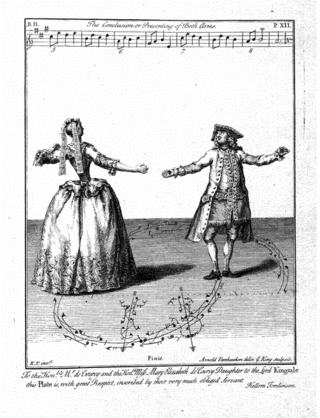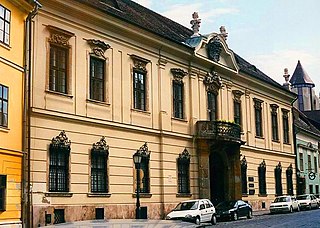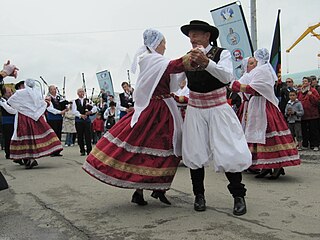
Baroque dance is dance of the Baroque era, closely linked with Baroque music, theatre, and opera.

Contra dance is a form of folk dancing made up of long lines of couples. It has mixed origins from English country dance, Scottish country dance, and French dance styles in the 17th century. Sometimes described as New England folk dance or Appalachian folk dance, contra dances can be found around the world, but are most common in the United States, Canada, and other Anglophone countries.

A folk dance is a dance that reflects the life of the people of a certain country or region. Not all ethnic dances are folk dances. For example, ritual dances or dances of ritual origin are not considered to be folk dances. Ritual dances are usually called "religious dances" because of their purpose.

The Ländler is a folk dance in 3
4 time which was popular in Austria, Bavaria, German Switzerland, and Slovenia at the end of the 18th century.
The Mazurka is a Polish musical form based on stylised folk dances in triple meter, usually at a lively tempo, with character defined mostly by the prominent mazur's "strong accents unsystematically placed on the second or third beat". The Mazurka, alongside the polka dance, became popular at the ballrooms and salons of Europe in the 19th century, particularly through the notable works by Frédéric Chopin. The mazurka and mazurek are often confused in Western literature as the same musical form.
In France, music reflects a diverse array of styles. In the field of classical music, France has produced several prominent romantic composers, while folk and popular music have seen the rise of the chanson and cabaret style. The oldest playable musical recordings were made in France using the earlist known sound recording device in the world, the phonautograph, which was patented by Édouard-Léon Scott de Martinville in 1857. France is also the 5th largest market by value in the world, and its music industry has produced many internationally renowned artists, especially in the nouvelle chanson and electronic music.

The schottische is a partnered country dance that apparently originated in Bohemia. It was popular in Victorian era ballrooms as a part of the Bohemian folk-dance craze and left its traces in folk music of countries such as Argentina, Finland, France, Italy, Norway ("reinlender"), Portugal and Brazil, Spain, Sweden, Denmark, Mexico, and the United States, among other nations. The schottische is considered by The Oxford Companion to Music to be a kind of slower polka, with continental-European origin.
Since the early 1970s, Brittany has experienced a tremendous revival of its folk music. Along with flourishing traditional forms such as the bombard-biniou pair and fest-noz ensembles incorporating other additional instruments, it has also branched out into numerous subgenres.
This is an alphabetical index of articles related to dance.

Coppélia is a comic ballet from 1870 originally choreographed by Arthur Saint-Léon to the music of Léo Delibes, with libretto by Charles-Louis-Étienne Nuitter. Nuitter's libretto and mise-en-scène was based upon E. T. A. Hoffmann's short story Der Sandmann. In Greek, κοπέλα means young woman. Coppélia premiered on 25 May 1870 at the Théâtre Impérial de l'Opéra, with the 16-year-old Giuseppina Bozzacchi in the principal role of Swanhilda and ballerina Eugénie Fiocre playing the part of Frantz en travesti. The costumes were designed by Paul Lormier and Alfred Albert, the scenery by Charles-Antoine Cambon, and Édouard Desplechin and Jean-Baptiste Lavastre.
The music of Saint Lucia is home to many vibrant oral and folk traditions and is based on elements derived from the music of Africa, especially rhythmically, and Western Europe, dances like the quadrille, polka and waltz. The banjo and cuatro are iconic Lucian folk instruments, especially a four-stringed banjo called the bwa poye. Celebratory songs called jwé show lyricism, and rhythmic complexity. The most important of the Afro-Lucian Creole folk dances is the kwadril. Music is an integral part of Lucian folk holidays and celebrations, as well as the good-natured rivalry between the La Rose and La Marguerite societies. There is little Western classical music on Saint Lucia, and the country's popular music industry is only nascent. There are few recording opportunities, though live music and radio remain a vital part of Lucian culture. Popular music from abroad, especially Trinidadian styles like calypso and soca, is widespread.

A fest noz is a Breton traditional festival, with dancing in groups and live musicians playing acoustic instruments.

As Europe experienced a wave of roots revivals in the 1950s and 1960s, France found its regional culture reviving traditional music. Brittany, Limousin, Gascony, Corsica and Auvergne were among the regions that experienced a notable resurgence in the popularity of folk music. Traditional styles of music had survived most in remote areas, such as the island of Corsica and mountainous Auvergne, as well as the more nationalist lands of the Basques and Bretons.

Budapest has long been an important part of the music of Hungary. Its music history has included the composers Franz Liszt, Ernő Dohnányi, Zoltán Kodály and Béla Bartók and the opera composer Ferenc Erkel.

Breton dance is a group of traditional dance forms originating in Brittany, the Celtic region of France. The dance has experienced a reappropriation in the late 1950s, with the development of the Celtic Circles and Fest Noz.
Jet Zoon is a Dutch diatonic accordionist/composer and winner of Nederlands Blazers Ensemble's jongNBE young composers competition for her piece, "Zooi op Zolder", which she performed in the VARA New Year's Concert in 2006 at the Concertgebouw in Amsterdam. Having discovered the diatonic accordion at age 7, Zoon studied under Judica Lookman, Roberto Tombesi, Ronan Robert, Luke Daniels, Jannick Martin and Bruno Letron at the Accademia del Mantice. Zoon currently performs alongside cellist Tessel Grijp and contrabass player Paul de Vriesband in the band Koek. Zoon has performed with Koek all across Europe, playing repertoire focused on balfolk of central France, as well as music from the Balkans and Italy, including an dro, bouree, polka, mazurka, rondeau, cercle, jig, and other styles. In October 2009, Zoon and bandmates Karlijn Swart (flute) and Joris Alblas (guitar) debuted at Theater de Musketon in Utrecht as Annie en de Boswachter.

Red Cardell is a French, Breton rock band, that mixes Breton music with rock, folk, blues, world music and chanson réaliste.

The Chapelloise or Belgijka is a traditional folk dance with change of partners, belonging to the standard repertoire of a Bal Folk. Its most common name in France and the French-influenced European Bal Folk scene is Chapelloise, but the dance has many other names too. In Poland, the dance is known under the name "belgijka", where it is very popular.
European dances refers to various dances originating in Europe. Since the Middle Ages, many European dances tend to be refined, as some are based on the court dances of aristocrats.












